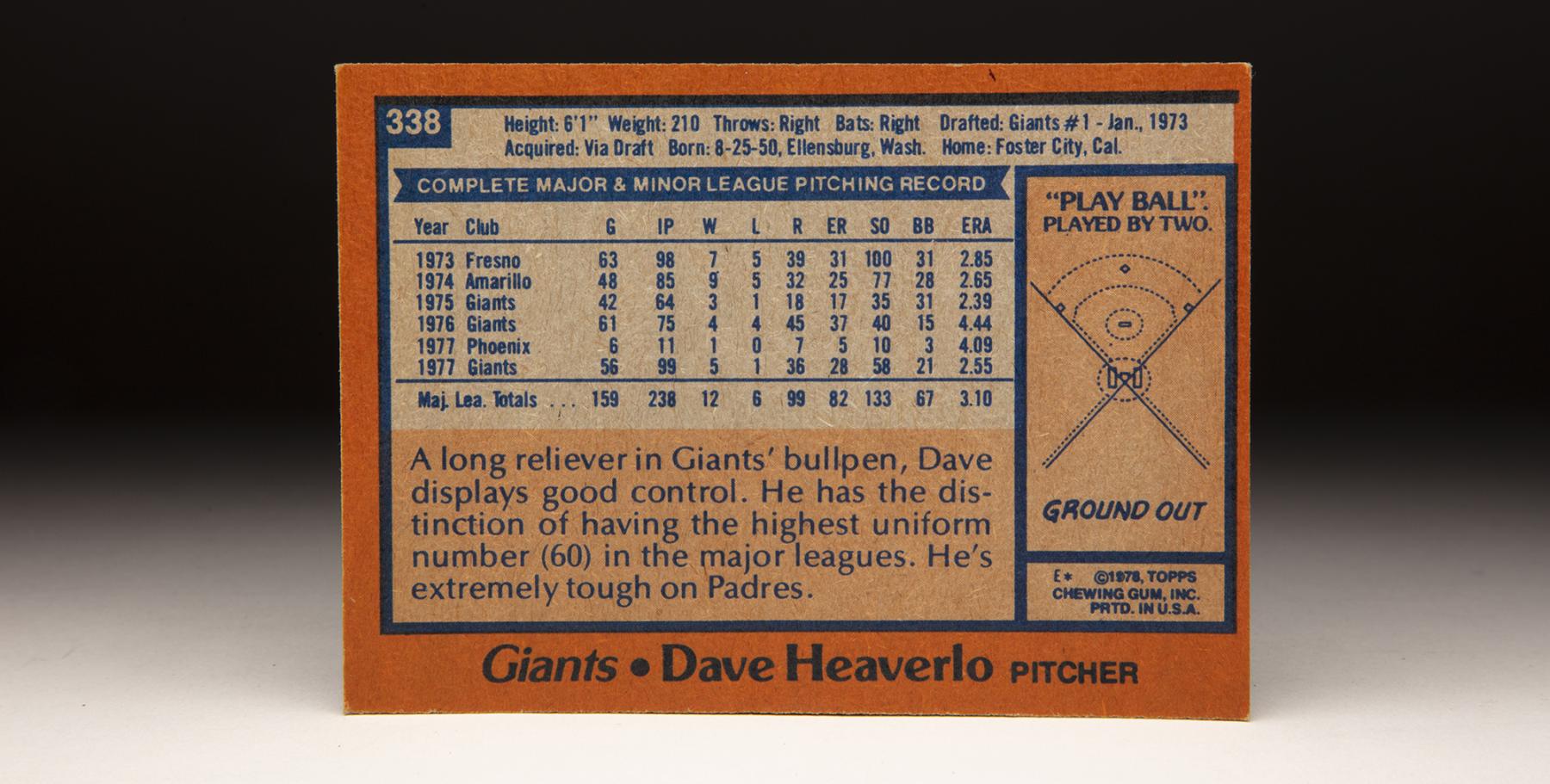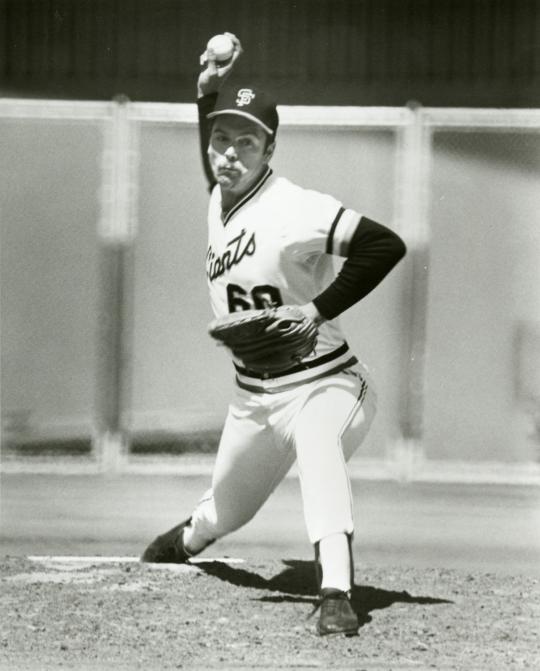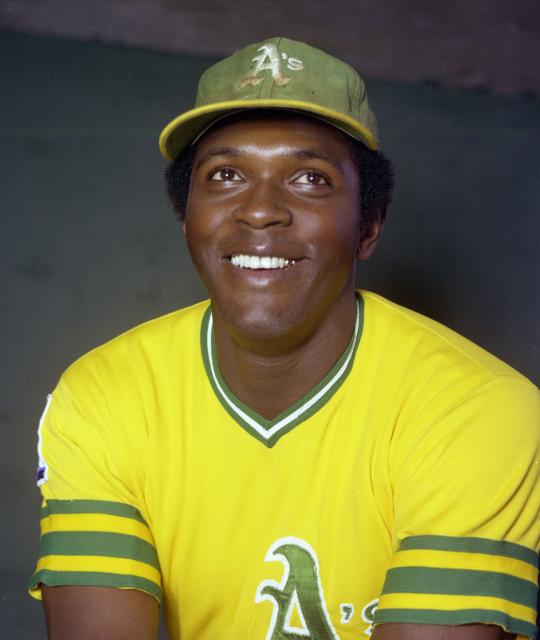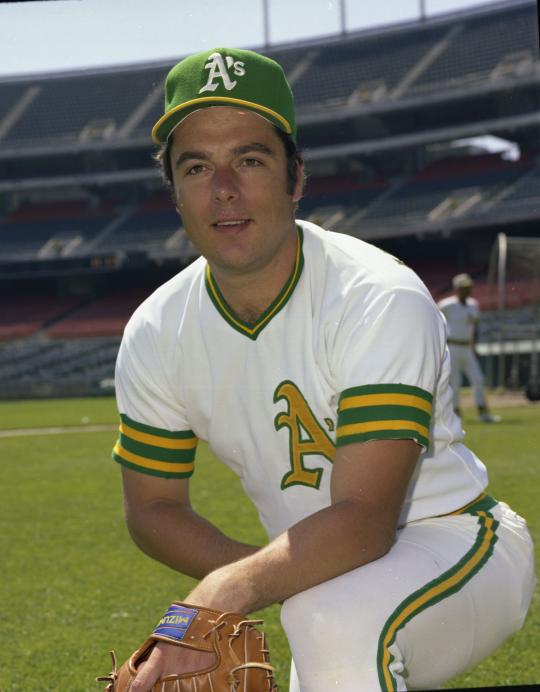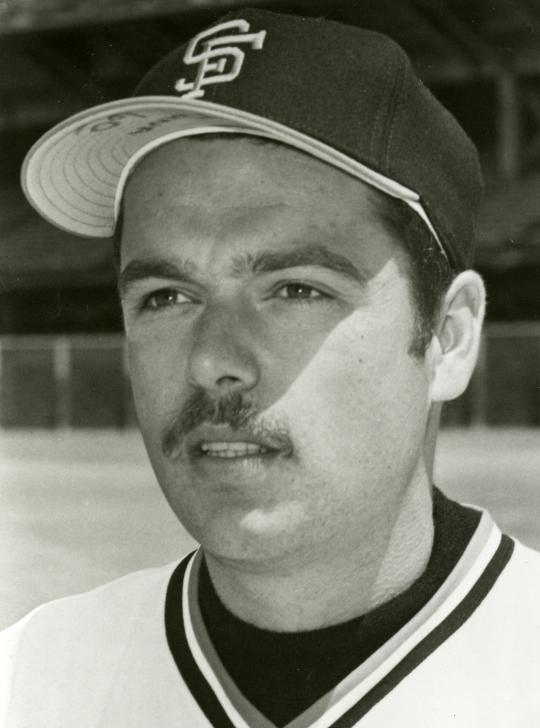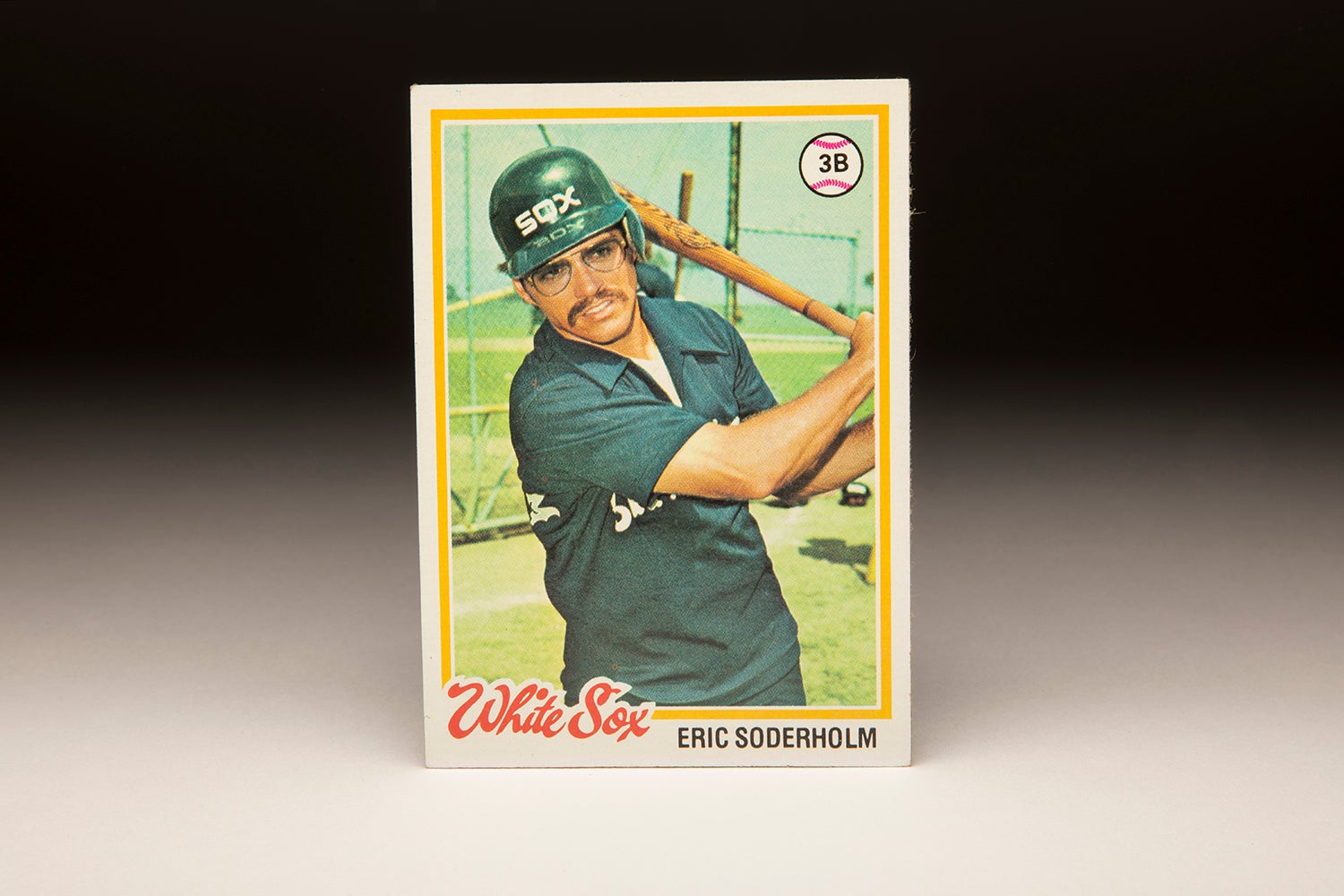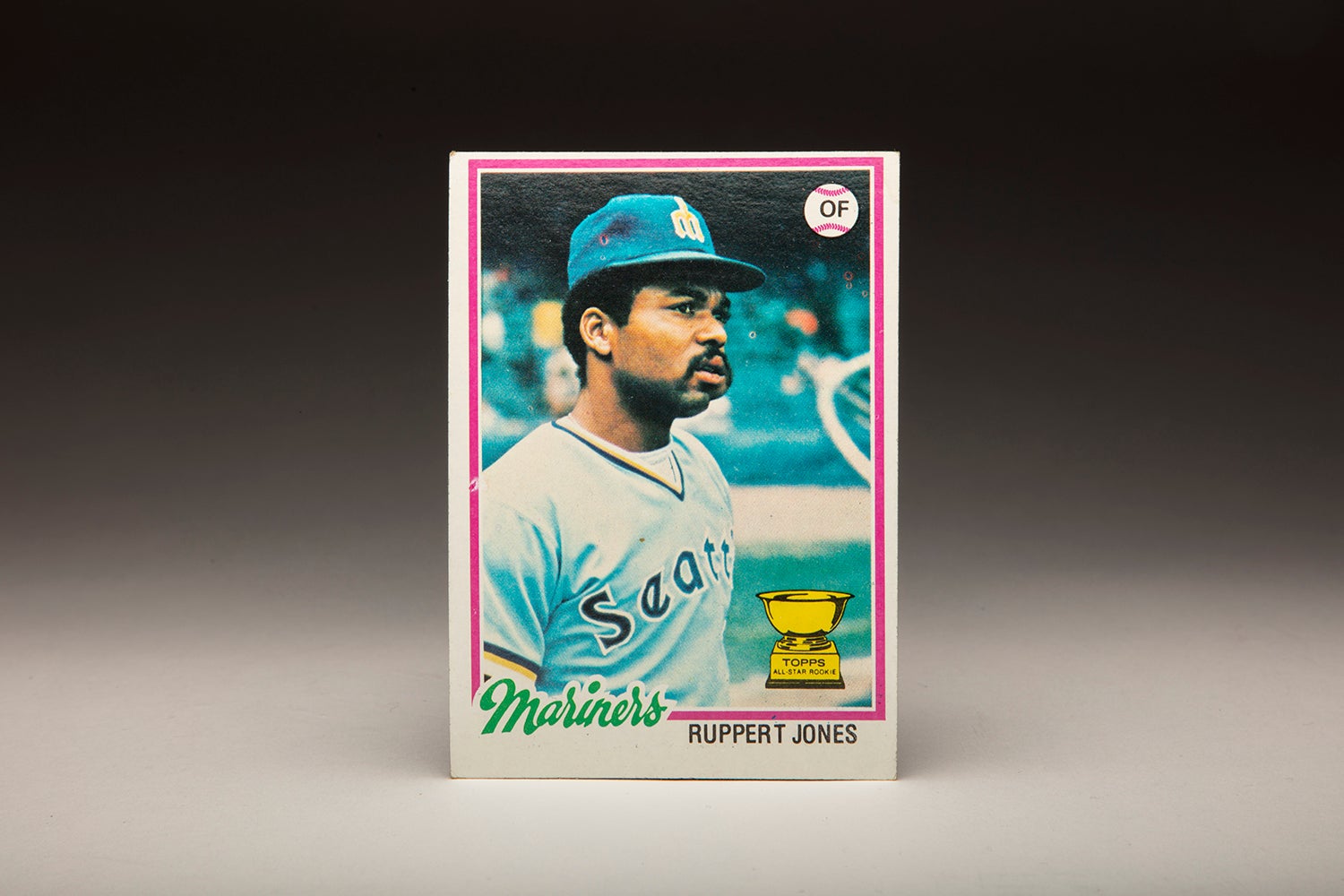- Home
- Our Stories
- #CardCorner: 1978 Topps Dave Heaverlo
#CardCorner: 1978 Topps Dave Heaverlo
Hall of Fame staffers are also baseball fans and love to share their stories. Here is a fan's perspective from Cooperstown.
The third base dugout at Candlestick Park was a popular vantage point for cards in Topps’ 1978 set. It’s always easy to pick out Candlestick during this era; the faded artificial turf, the metal fence, and the 375-foot marker in right field help make these dead giveaways for “The Stick,” whose cold winds made it one of the least-favored parks among players of that era. Taken during actual games in 1977, these Candlestick shots not only captured several members of the San Francisco Giants (including Darrell Evans, Jim Barr and Ed Halicki), but also provided imagery for several opposing players, including Rich “Goose” Gossage, Bruce Kison and Jim Lonborg. (The Kison card has been profiled in an earlier edition of Card Corner.)
Among the Giants to be featured in this informal subset of cards was a relatively little known but colorful pitcher named Dave Heaverlo. A right-handed reliever, Heaverlo was perhaps best known for three things: Throwing sidearm, sporting a Fu Manchu mustache at times and having a shaved head. Only one of those characteristics is in evidence on the card. Based on the angle of his arm, we can see the beginnings of Heaverlo’s sidearm/three-quarters delivery. But there is no mustache yet, and his head is still full of dark hair, which we can see popping out from underneath his black Giants cap. Heaverlo wouldn’t adopt the shaved look until later, at a time when few players dared apply a razor to their scalps.
Heaverlo also became a source of debate among young fans of the 1970s. How exactly do you pronounce his last name? I and my friends had always assumed that it was pronounced HEAVE-er-loh, which was an especially apt pronunciation for a pitcher. But I heard other fans refer to him as HEV-er-loh, which was not as fun. It turns out that both groups of fans were wrong; the name is actually pronounced HAVE-er-loh, as I was informed not that long ago.
While it took a while for me to figure out how to pronounce Heaverlo’s name, it didn’t take nearly as long for Heaverlo to make the major leagues after being drafted by the San Diego Padres in 1972. Heaverlo chose not to sign with San Diego, leaving him available for the January phase of the 1973 draft by the Giants. This time Heaverlo did sign, enabling him to begin his professional career that spring. He would spend only two seasons in the minor leagues, making a quick ascent to San Francisco by 1975.
While his minor league tenure was brief, it was also eventful. Late in the 1974 season, Heaverlo was pitching for the Amarillo Giants, San Francisco’s affiliate in the Texas League. Heaverlo and one of his teammates went to a local bar, where a fight broke out. Heaverlo and the other player tried to break up the altercation. As Heaverlo made his way toward the exit of the bar, one of the assailants fired a gun, the bullet striking Heaverlo in the left hand. Tragically, another gunshot left one of the assailants dead. In the meantime, Heaverlo was treated at a local hospital, somewhat fortunate in that he had been wounded only in his left hand, and not his pitching arm.
In spite of the incident, Heaverlo would make the Giants’ Opening Day roster the following spring. He joined a solid bullpen that featured veterans Randy Moffitt, Charlie Williams and Gary Lavelle. Manager Wes Westrum called on Heaverlo to pitch in middle relief; the rookie responded well, carving out an ERA of 2.39 in 42 games. Heaverlo allowed his fair share of baserunners (a total of 93 in 64 innings), but his ability to induce double plays and wiggle out of jams made him effective at preventing runs.
Playing in his first season, Heaverlo wore the No. 60, considered a high number for a player, but a number that was also typical for rookies. Most players, as they gain seniority, opt for lower uniform numbers, but the free-spirited Heaverlo kept the No. 60. He claimed that he liked the number because it was the year (1960) that he had graduated from elementary school.
As a rookie, Heaverlo also showed off his penchant for snappy one-liners. When a reporter asked him about his ongoing battle with keeping weight off, Heaverlo told him, “How can you keep your weight off when you’re a part-time bartender in a pizza parlor during the offseason?”
It was also during his rookie season that Heaverlo started doing something rarely seen among major leaguers: Completely shaving his head. The daily habit earned him the nickname of Kojak, a reference to the popular 1970s crime drama that starred the famously bald actor, Telly Savalas, as the title character. On the Giants, Heaverlo’s bald head made him stand out even more, given that a number of his teammates decided to perm their hair, including staff ace John “The Count” Montefusco. But not Heaverlo; there was simply nothing to perm.
In 1976, Heaverlo fell victim to the dreaded “sophomore jinx.” More likely, National League hitters simply adjusted to his mix of forkballs and sinkers, which he had to rely on in the absence of an overpowering fastball. Heaverlo walked only 15 batters in 75 innings, but his stuff proved very hittable, as his ERA rose to 4.44.
On the field, Heaverlo’s 1976 struggles played a part in his 1977 fate; he started the season at Triple-A Phoenix, where he made six appearances before receiving a callback to San Francisco. Making some needed adjustments, Heaverlo emerged as a workhorse out of the bullpen. Logging a total of 98 innings, he lowered his ERA to 2.55 and won five of six decisions.
Thanks to a bounce-back season by the Bay, Heaverlo seemed to be in good stead with the Giants. Over his three years in San Francisco, he had averaged 53 games a season, while putting up an ERA of 3.11. But the Giants also felt that they couldn’t trust Heaverlo to hold leads, making them reluctant to use him in save situations. That winter, when Oakland A’s star left-hander Vida Blue became available in a trade, the Giants formulated a package – one that included Heaverlo. Along with catcher Gary Alexander, outfielder Gary Thomasson and several young pitchers, Heaverlo headed across the Bay to Oakland in a massive deal for Blue.
With the rebuilding A’s, Heaverlo found an expanded role. Managers Bobby Winkles and Jack McKeon called on him often, 69 times in total for a whopping 130 innings, all in relief. For the first time in his career, he received a number of opportunities to close out games. Sharing the relief ace role with Elias Sosa, Heaverlo picked up 10 saves, a career high. Heaverlo pitched well in the ironman role, but the heavy workload took a toll the following season.
He again pitched in a high volume of games (62), but was not nearly as effective, his ERA rising to 4.20. It didn’t help matters that the A’s were awful; they lost nine of their first 11 games, on the way to a franchise record 108 losses. As Heaverlo would tell Vice Sports many years later, “I think we were mathematically eliminated coming out of Spring Training.”
In 1980, Heaverlo reported to Oakland’s spring site in Mesa, Ariz. He was looking forward to pitching for a new manager, Billy Martin, whom he would come to like and admire for the way that he helped out players who were struggling financially.
But Heaverlo’s role as Oakland’s player representative created a conflict with someone else within the organization. The veteran reliever had voiced complaints about owner and general manager Charlie Finley during the 1979 season, prompting some fans to send him vicious hate mail. In the spring of 1980, Heaverlo continued his complaints, expressing displeasure with Oakland’s Cactus League travel schedule.
He also decided to shave his head again, this time as a direct protest against Finley. Heaverlo announced that he would keep his head free of hair until Finley sold the team. And just to add some fun to the equation, Heaverlo took his shorn locks and mailed them to a teammate and friend, catcher Jeff Newman, who was starting to lose his own hair.
Finley did not see the humor in Heaverlo’s protest. The owner placed him on waivers and then sold him to the Seattle Mariners for $50,000. When Heaverlo first heard reports that he had been sold, he told the Oakland beat writers that he had not been notified of the transaction, before offering one of his typically offbeat reactions. “I’ll wait until I hear from the A’s or the Mariners,” Heaverlo told the Associated Press. “I’ll check around and see how much volcano insurance is. I guess I’ll get a good look at Mount St. Helens (which was active in the spring of 1980).”
Heaverlo would get that chance – eventually. Due to the lateness of his move from Oakland to Seattle, he did not arrive at the Kingdome until the fifth inning on Opening Day. As fortune would have it, he entered the game in the eighth inning and picked up the save. Like the A’s, the Mariners used Heaverlo frequently. Over Seattle’s first 18 games, Heaverlo appeared in nine games. Such a pace continued briskly over the season. Appearing in 60 games, he posted an ERA of 3.89, which may have been attributable to overuse.
As a Mariner, Heaverlo enhanced his reputation for colorful behavior. At times, he donned a long-haired wig, covering his otherwise bald head. He also wore ghoulish masks to the ballpark, bringing some levity to a clubhouse that had been lacking in fun and humor.
Unfortunately, the spring of 1981 would turn sour for Heaverlo.
Once again, Heaverlo would not survive camp with his original team, this time cut loose by Seattle. It wasn’t so much that Heaverlo pitched poorly in exhibition games, but rather a conflict with manager Maury Wills that resulted in his outright release from the Mariners.
This time Heaverlo completed the circuit by returning to the A’s, who assigned him to Triple-A Tacoma. He later spent two stints with Oakland that year and pitched well for Billy Martin, but appeared in only six major league games. Over the next two seasons, Heaverlo spent most of his time on the disabled list because of arm problems. Over that span, he appeared in only four games for Tacoma, but never made it back to Oakland. At the end of the 1983 season, arm trouble convinced Heaverlo that it was time to retire.
Although known as a jokester, Heaverlo also understood the art of pitching and turned that knowledge into a successful career as a minor league pitching coach. He has also become a regular at fantasy camps for the A’s, where his outgoing personality often makes him the life of the camp – and the judge of the camp’s so-called “Kangaroo Kourt.” Additionally, the well-spoken Heaverlo has worked as a radio host in his childhood hometown of Moses Lake, Wash., another tribute to his engaging manner and spirited sense of humor.
All these years later, Heaverlo has maintained his humor and his self-deprecating nature. He also remains without hair. No, he’s not shaving his head every day. It’s simply a reality of advancing age.
Bruce Markusen is the manager of digital and outreach learning at the National Baseball Hall of Fame
Special thanks to Marty Lurie for his assistance with this article


